TOYOTA GT86 2014 Owners Manual (in English)
Manufacturer: TOYOTA, Model Year: 2014, Model line: GT86, Model: TOYOTA GT86 2014Pages: 452, PDF Size: 14.38 MB
Page 111 of 452
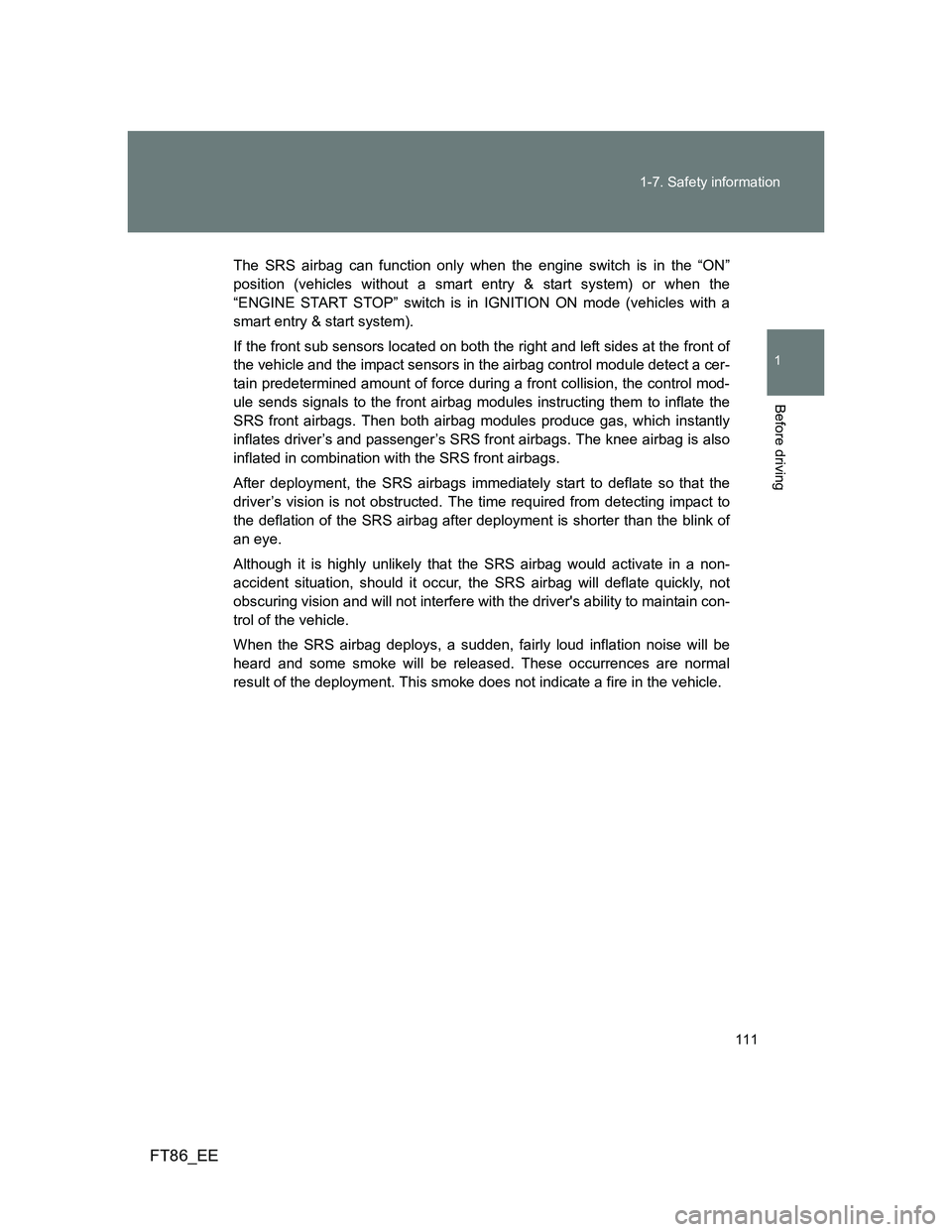
111 1-7. Safety information
1
Before driving
FT86_EE
The SRS airbag can function only when the engine switch is in the “ON”
position (vehicles without a smart entry & start system) or when the
“ENGINE START STOP” switch is in IGNITION ON mode (vehicles with a
smart entry & start system).
If the front sub sensors located on both the right and left sides at the front of
the vehicle and the impact sensors in the airbag control module detect a cer-
tain predetermined amount of force during a front collision, the control mod-
ule sends signals to the front airbag modules instructing them to inflate the
SRS front airbags. Then both airbag modules produce gas, which instantly
inflates driver’s and passenger’s SRS front airbags. The knee airbag is also
inflated in combination with the SRS front airbags.
After deployment, the SRS airbags immediately start to deflate so that the
driver’s vision is not obstructed. The time required from detecting impact to
the deflation of the SRS airbag after deployment is shorter than the blink of
an eye.
Although it is highly unlikely that the SRS airbag would activate in a non-
accident situation, should it occur, the SRS airbag will deflate quickly, not
obscuring vision and will not interfere with the driver's ability to maintain con-
trol of the vehicle.
When the SRS airbag deploys, a sudden, fairly loud inflation noise will be
heard and some smoke will be released. These occurrences are normal
result of the deployment. This smoke does not indicate a fire in the vehicle.
Page 112 of 452
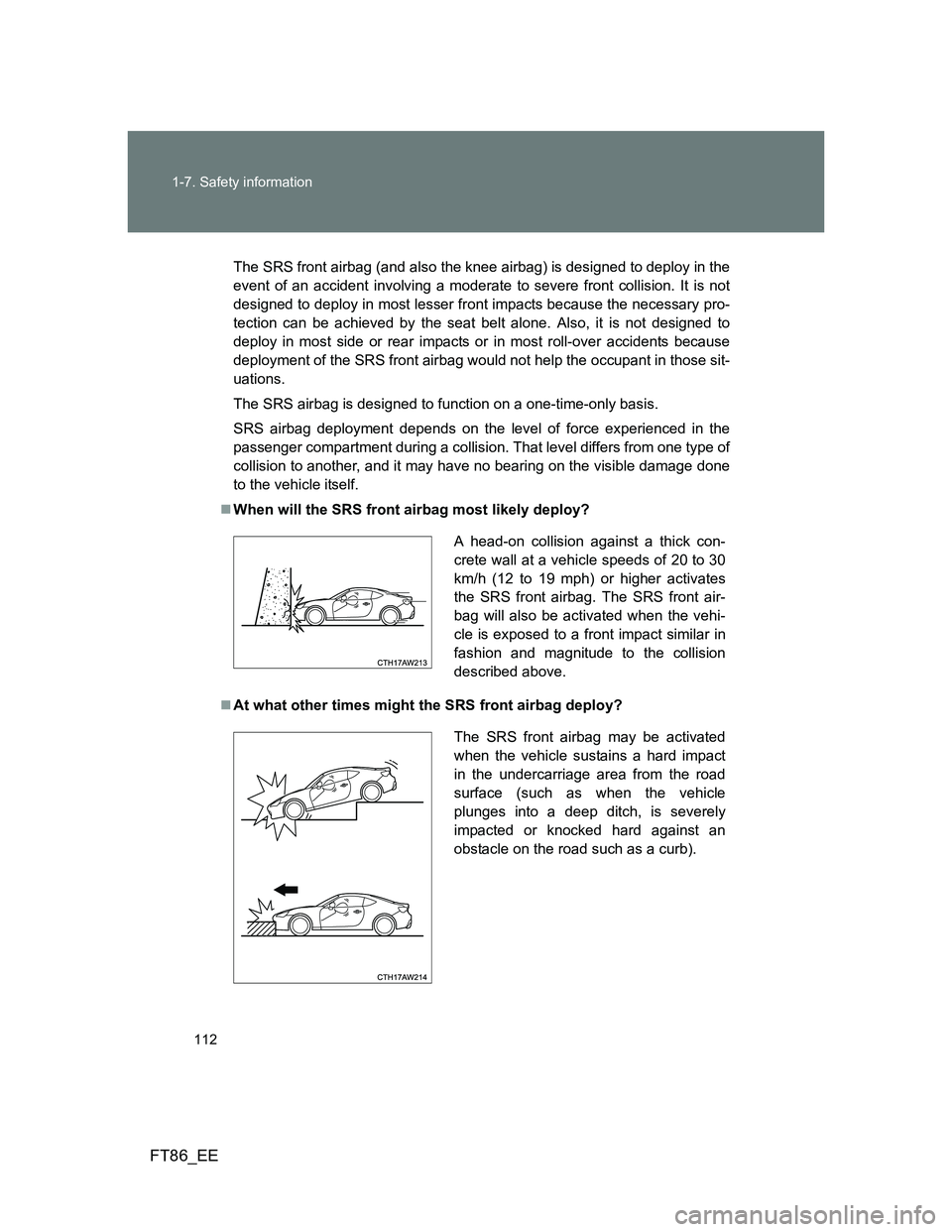
112 1-7. Safety information
FT86_EE
The SRS front airbag (and also the knee airbag) is designed to deploy in the
event of an accident involving a moderate to severe front collision. It is not
designed to deploy in most lesser front impacts because the necessary pro-
tection can be achieved by the seat belt alone. Also, it is not designed to
deploy in most side or rear impacts or in most roll-over accidents because
deployment of the SRS front airbag would not help the occupant in those sit-
uations.
The SRS airbag is designed to function on a one-time-only basis.
SRS airbag deployment depends on the level of force experienced in the
passenger compartment during a collision. That level differs from one type of
collision to another, and it may have no bearing on the visible damage done
to the vehicle itself.
When will the SRS front airbag most likely deploy?
At what other times might the SRS front airbag deploy?
A head-on collision against a thick con-
crete wall at a vehicle speeds of 20 to 30
km/h (12 to 19 mph) or higher activates
the SRS front airbag. The SRS front air-
bag will also be activated when the vehi-
cle is exposed to a front impact similar in
fashion and magnitude to the collision
described above.
The SRS front airbag may be activated
when the vehicle sustains a hard impact
in the undercarriage area from the road
surface (such as when the vehicle
plunges into a deep ditch, is severely
impacted or knocked hard against an
obstacle on the road such as a curb).
Page 113 of 452
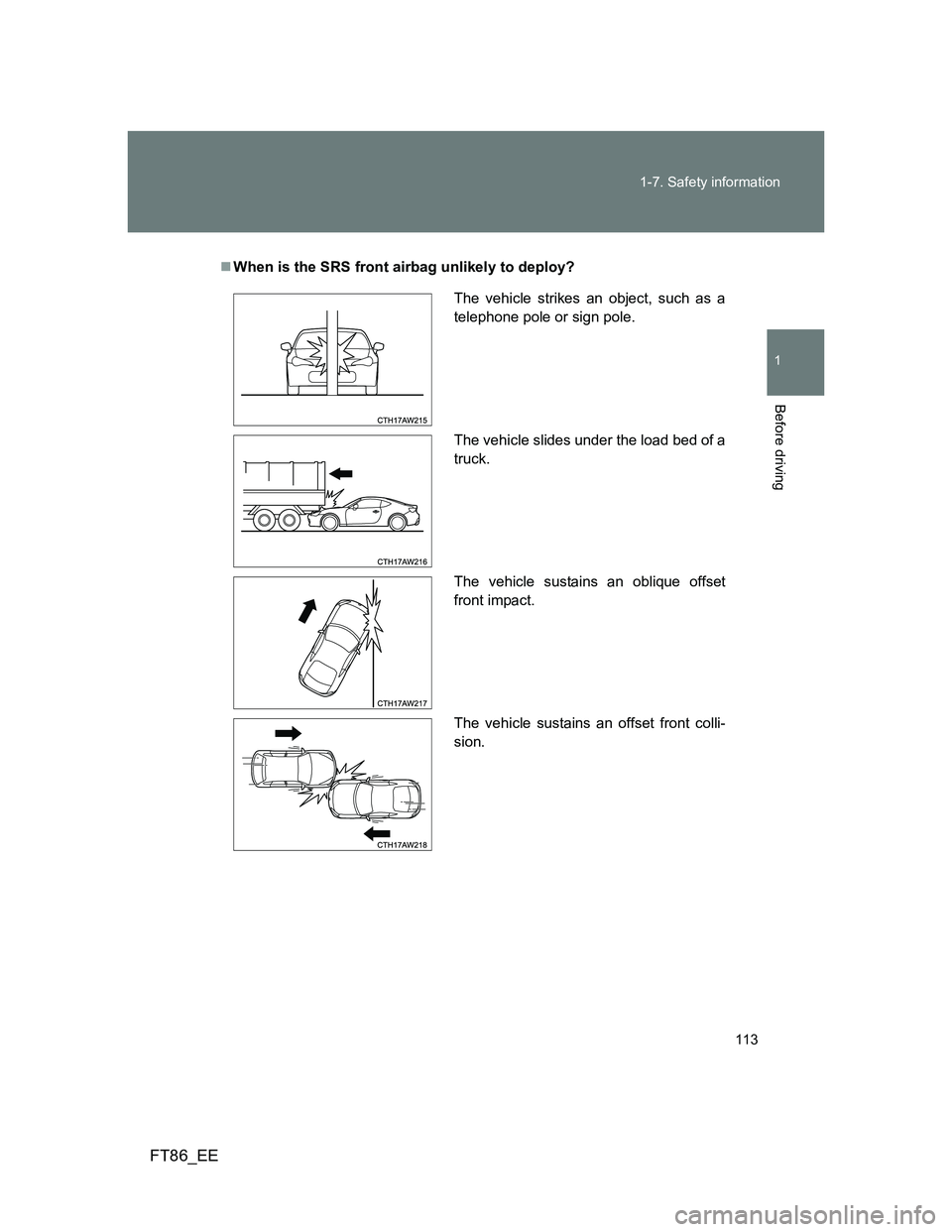
113 1-7. Safety information
1
Before driving
FT86_EE
When is the SRS front airbag unlikely to deploy?
The vehicle strikes an object, such as a
telephone pole or sign pole.
The vehicle slides under the load bed of a
truck.
The vehicle sustains an oblique offset
front impact.
The vehicle sustains an offset front colli-
sion.
Page 114 of 452
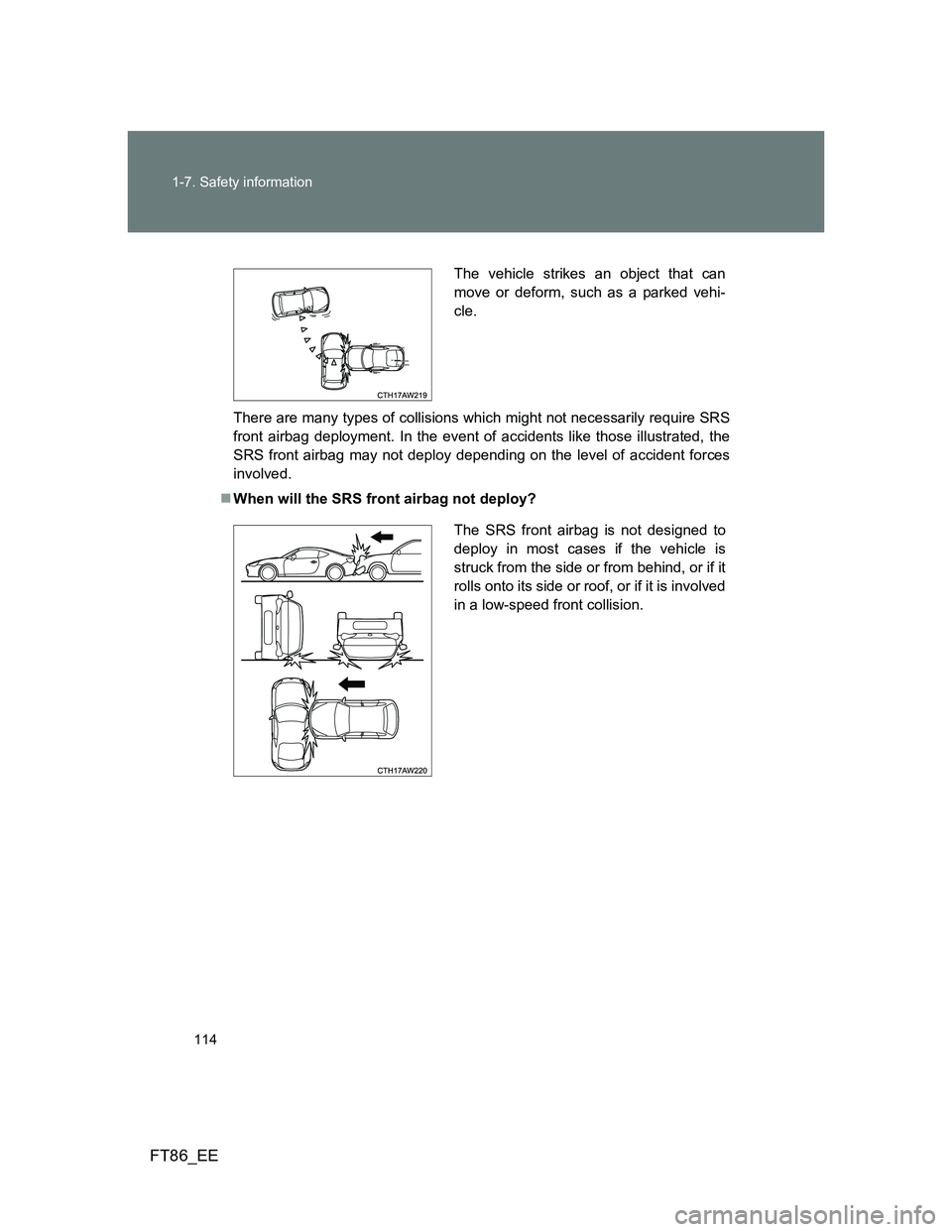
114 1-7. Safety information
FT86_EE
There are many types of collisions which might not necessarily require SRS
front airbag deployment. In the event of accidents like those illustrated, the
SRS front airbag may not deploy depending on the level of accident forces
involved.
When will the SRS front airbag not deploy?
The vehicle strikes an object that can
move or deform, such as a parked vehi-
cle.
The SRS front airbag is not designed to
deploy in most cases if the vehicle is
struck from the side or from behind, or if it
rolls onto its side or roof, or if it is involved
in a low-speed front collision.
Page 115 of 452
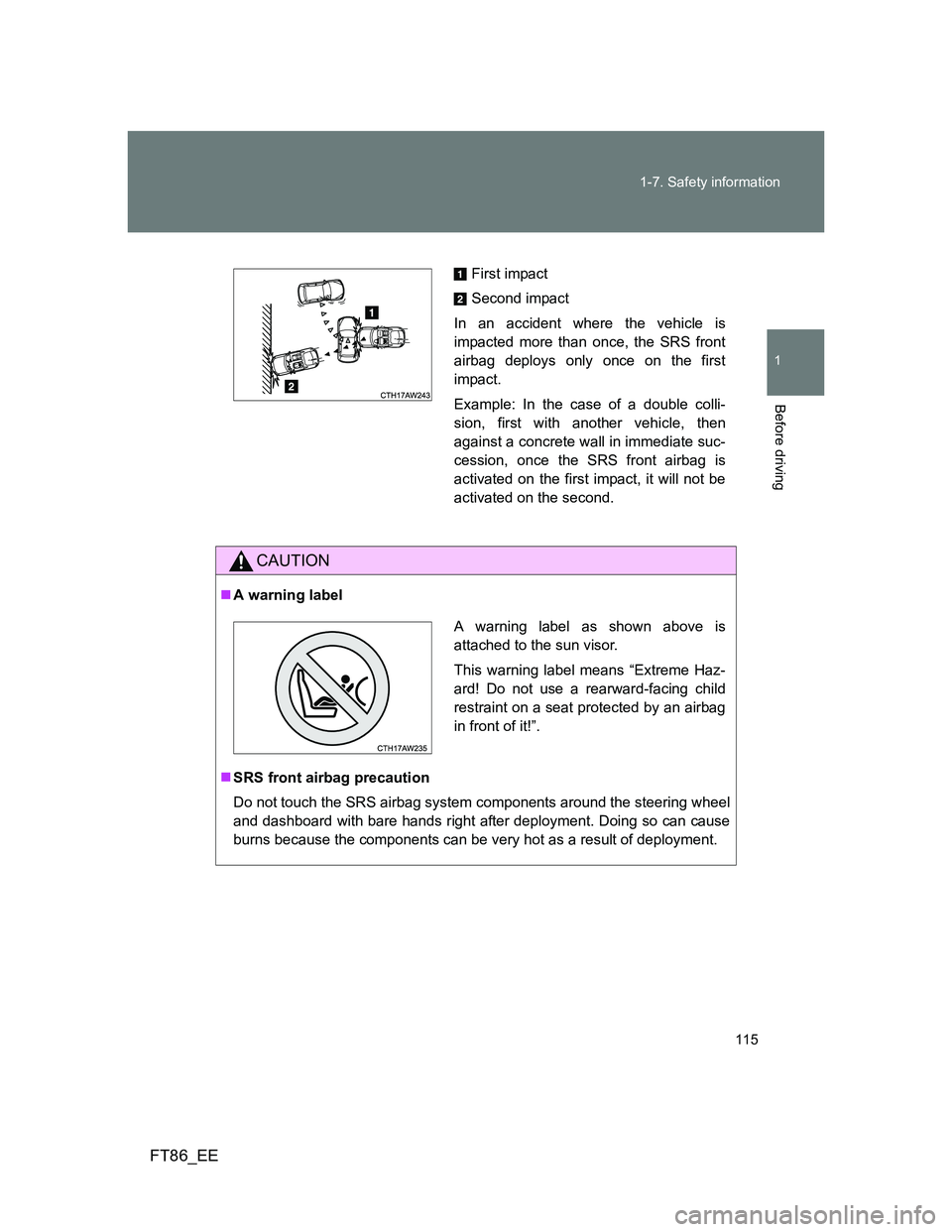
115 1-7. Safety information
1
Before driving
FT86_EE
CAUTION
A warning label
SRS front airbag precaution
Do not touch the SRS airbag system components around the steering wheel
and dashboard with bare hands right after deployment. Doing so can cause
burns because the components can be very hot as a result of deployment.
First impact
Second impact
In an accident where the vehicle is
impacted more than once, the SRS front
airbag deploys only once on the first
impact.
Example: In the case of a double colli-
sion, first with another vehicle, then
against a concrete wall in immediate suc-
cession, once the SRS front airbag is
activated on the first impact, it will not be
activated on the second.
A warning label as shown above is
attached to the sun visor.
This warning label means “Extreme Haz-
ard! Do not use a rearward-facing child
restraint on a seat protected by an airbag
in front of it!”.
Page 116 of 452
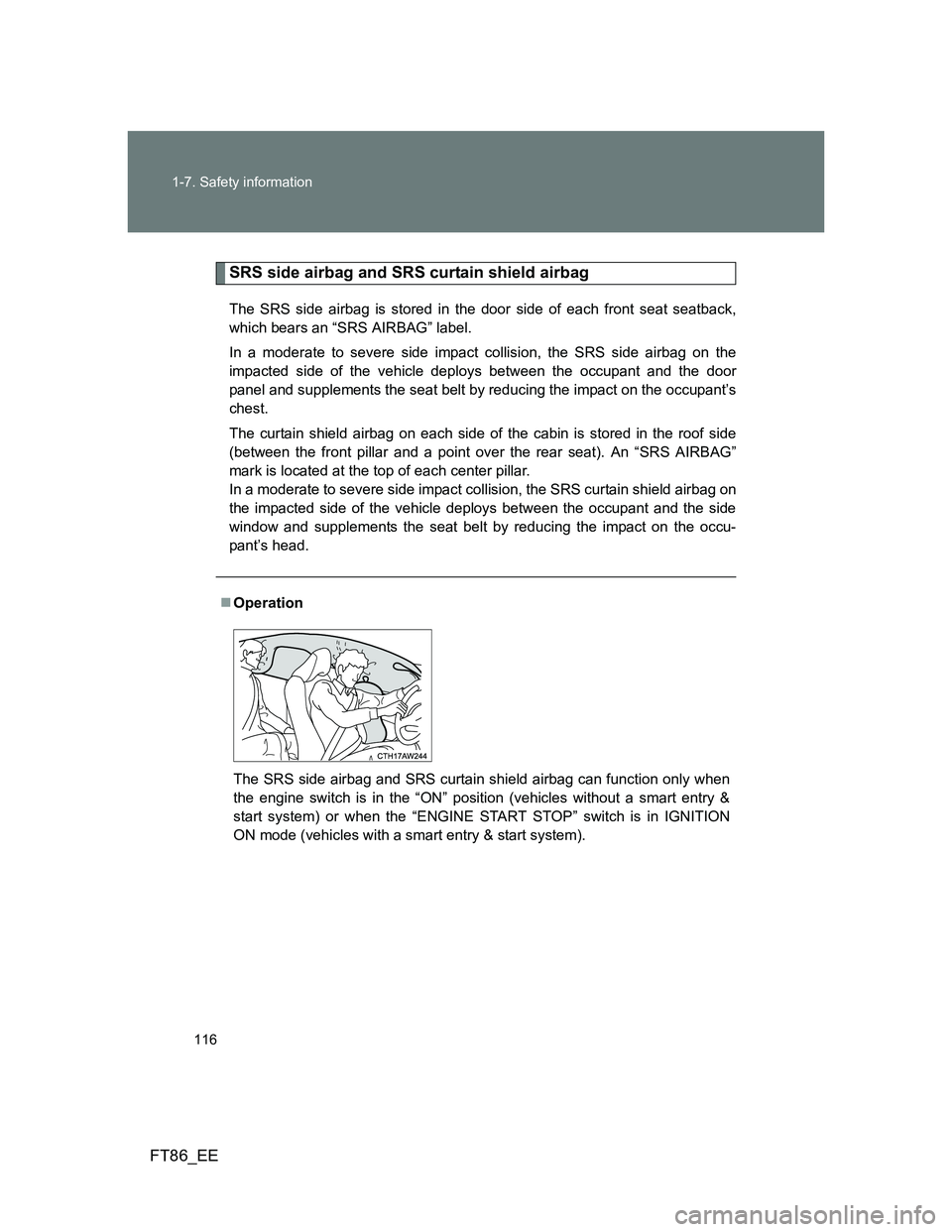
116 1-7. Safety information
FT86_EE
SRS side airbag and SRS curtain shield airbag
The SRS side airbag is stored in the door side of each front seat seatback,
which bears an “SRS AIRBAG” label.
In a moderate to severe side impact collision, the SRS side airbag on the
impacted side of the vehicle deploys between the occupant and the door
panel and supplements the seat belt by reducing the impact on the occupant’s
chest.
The curtain shield airbag on each side of the cabin is stored in the roof side
(between the front pillar and a point over the rear seat). An “SRS AIRBAG”
mark is located at the top of each center pillar.
In a moderate to severe side impact collision, the SRS curtain shield airbag on
the impacted side of the vehicle deploys between the occupant and the side
window and supplements the seat belt by reducing the impact on the occu-
pant’s head.
Operation
The SRS side airbag and SRS curtain shield airbag can function only when
the engine switch is in the “ON” position (vehicles without a smart entry &
start system) or when the “ENGINE START STOP” switch is in IGNITION
ON mode (vehicles with a smart entry & start system).
Page 117 of 452
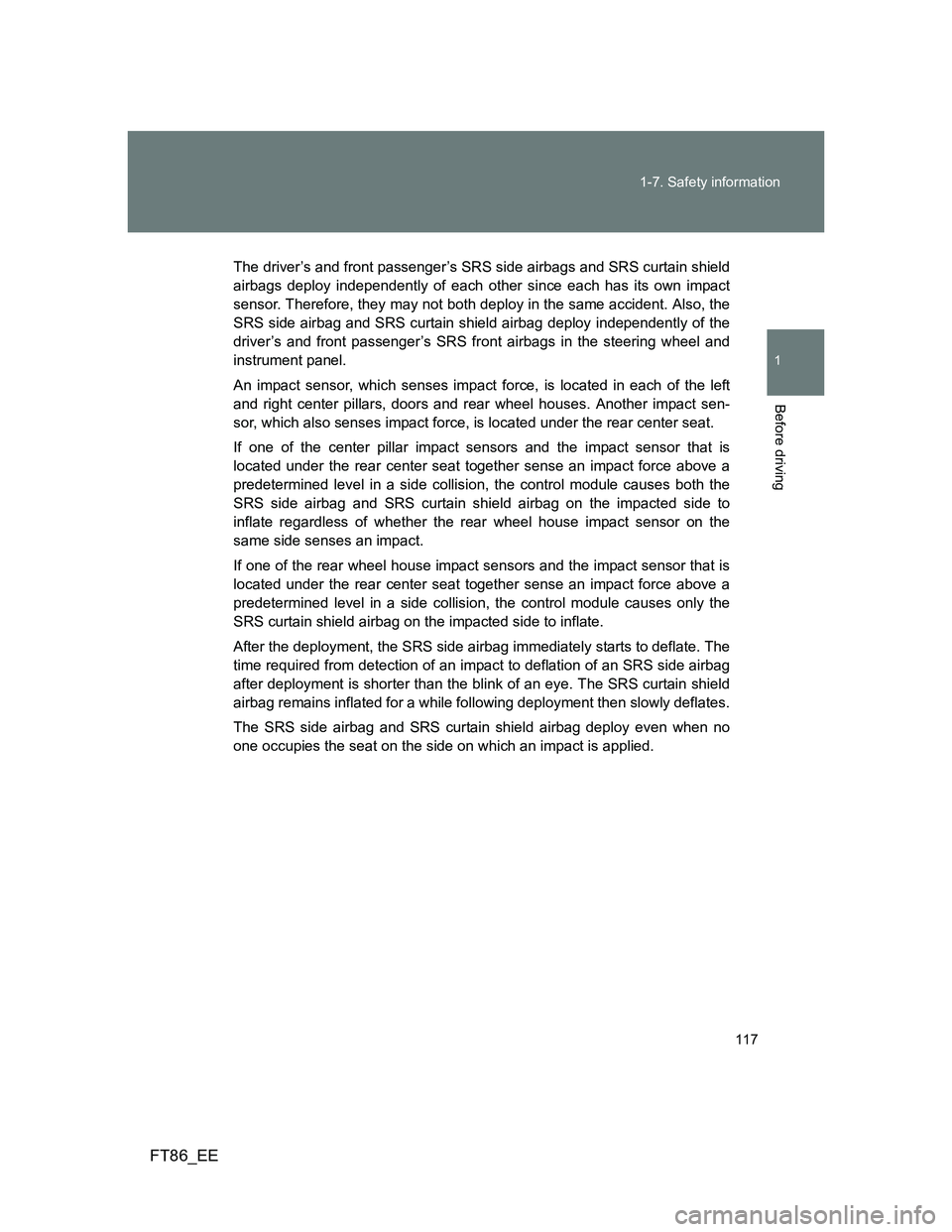
117 1-7. Safety information
1
Before driving
FT86_EE
The driver’s and front passenger’s SRS side airbags and SRS curtain shield
airbags deploy independently of each other since each has its own impact
sensor. Therefore, they may not both deploy in the same accident. Also, the
SRS side airbag and SRS curtain shield airbag deploy independently of the
driver’s and front passenger’s SRS front airbags in the steering wheel and
instrument panel.
An impact sensor, which senses impact force, is located in each of the left
and right center pillars, doors and rear wheel houses. Another impact sen-
sor, which also senses impact force, is located under the rear center seat.
If one of the center pillar impact sensors and the impact sensor that is
located under the rear center seat together sense an impact force above a
predetermined level in a side collision, the control module causes both the
SRS side airbag and SRS curtain shield airbag on the impacted side to
inflate regardless of whether the rear wheel house impact sensor on the
same side senses an impact.
If one of the rear wheel house impact sensors and the impact sensor that is
located under the rear center seat together sense an impact force above a
predetermined level in a side collision, the control module causes only the
SRS curtain shield airbag on the impacted side to inflate.
After the deployment, the SRS side airbag immediately starts to deflate. The
time required from detection of an impact to deflation of an SRS side airbag
after deployment is shorter than the blink of an eye. The SRS curtain shield
airbag remains inflated for a while following deployment then slowly deflates.
The SRS side airbag and SRS curtain shield airbag deploy even when no
one occupies the seat on the side on which an impact is applied.
Page 118 of 452
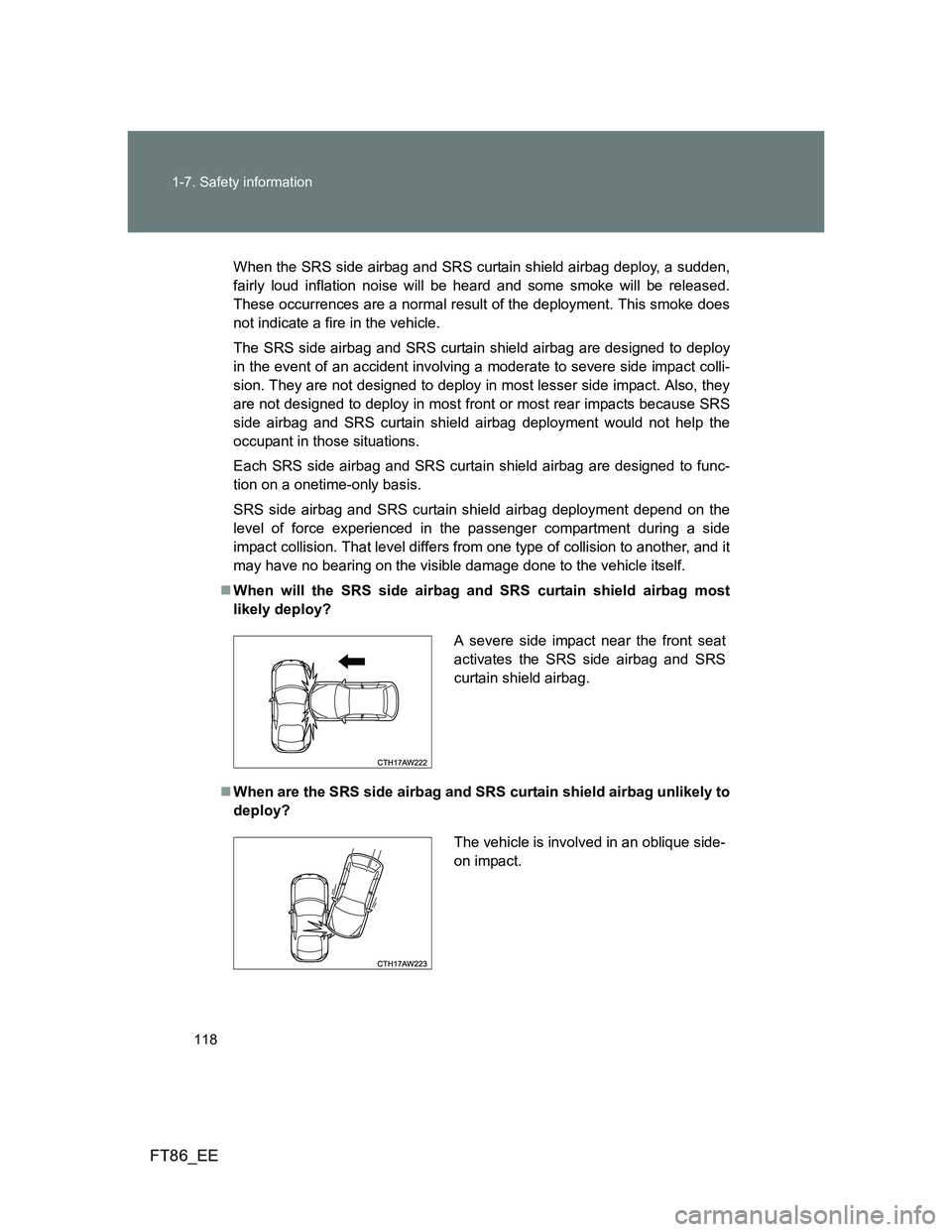
118 1-7. Safety information
FT86_EE
When the SRS side airbag and SRS curtain shield airbag deploy, a sudden,
fairly loud inflation noise will be heard and some smoke will be released.
These occurrences are a normal result of the deployment. This smoke does
not indicate a fire in the vehicle.
The SRS side airbag and SRS curtain shield airbag are designed to deploy
in the event of an accident involving a moderate to severe side impact colli-
sion. They are not designed to deploy in most lesser side impact. Also, they
are not designed to deploy in most front or most rear impacts because SRS
side airbag and SRS curtain shield airbag deployment would not help the
occupant in those situations.
Each SRS side airbag and SRS curtain shield airbag are designed to func-
tion on a onetime-only basis.
SRS side airbag and SRS curtain shield airbag deployment depend on the
level of force experienced in the passenger compartment during a side
impact collision. That level differs from one type of collision to another, and it
may have no bearing on the visible damage done to the vehicle itself.
When will the SRS side airbag and SRS curtain shield airbag most
likely deploy?
When are the SRS side airbag and SRS curtain shield airbag unlikely to
deploy?
A severe side impact near the front seat
activates the SRS side airbag and SRS
curtain shield airbag.
The vehicle is involved in an oblique side-
on impact.
Page 119 of 452
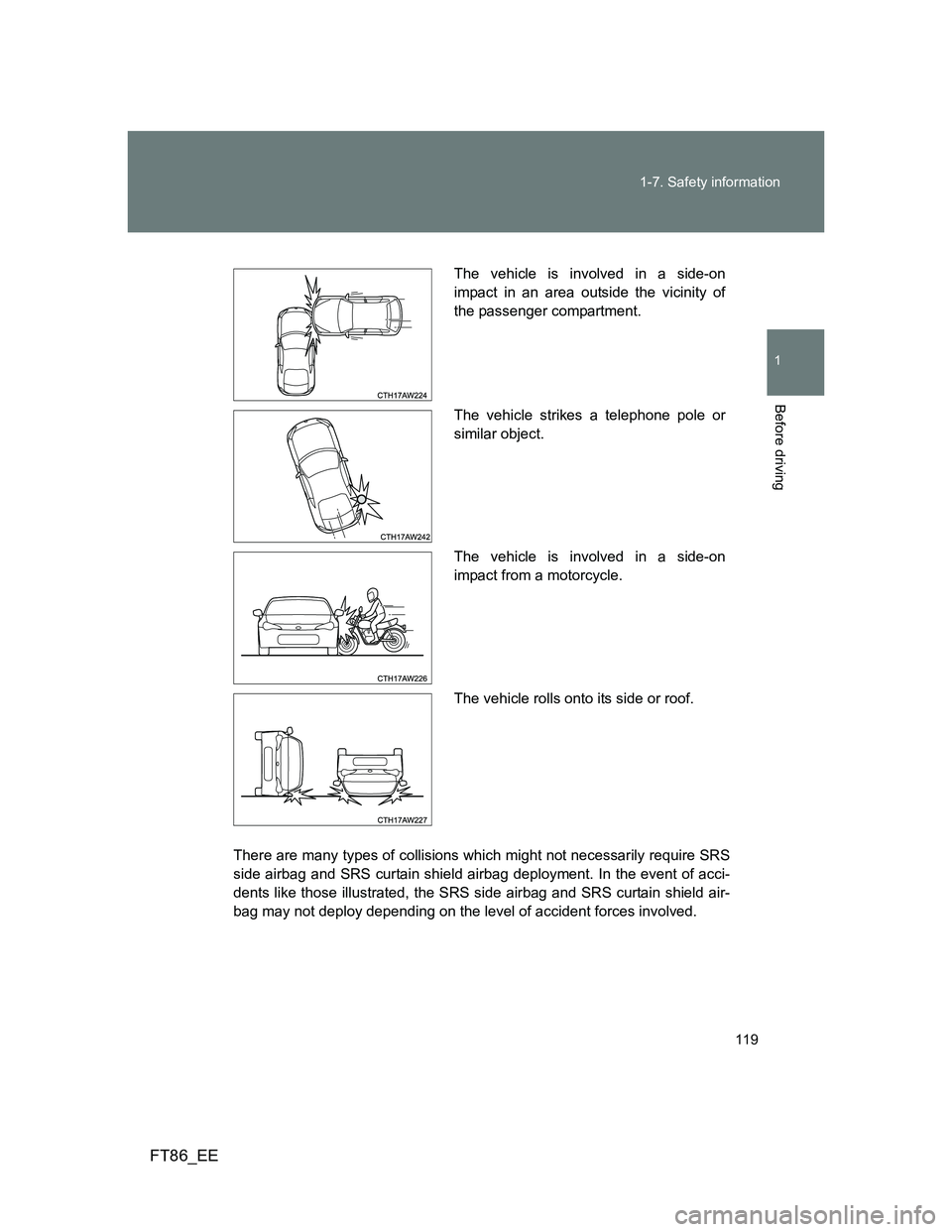
119 1-7. Safety information
1
Before driving
FT86_EE
There are many types of collisions which might not necessarily require SRS
side airbag and SRS curtain shield airbag deployment. In the event of acci-
dents like those illustrated, the SRS side airbag and SRS curtain shield air-
bag may not deploy depending on the level of accident forces involved.
The vehicle is involved in a side-on
impact in an area outside the vicinity of
the passenger compartment.
The vehicle strikes a telephone pole or
similar object.
The vehicle is involved in a side-on
impact from a motorcycle.
The vehicle rolls onto its side or roof.
Page 120 of 452
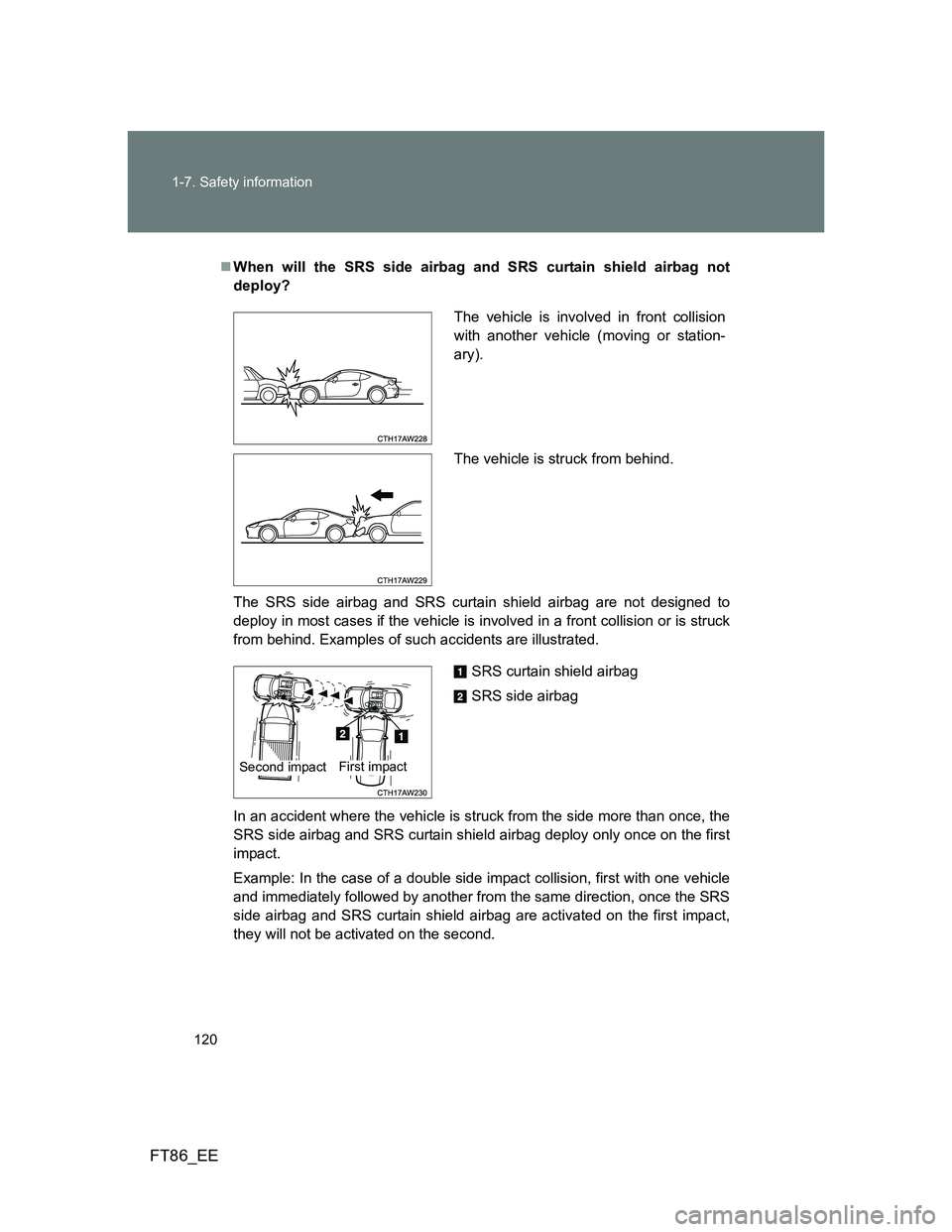
120 1-7. Safety information
FT86_EE
When will the SRS side airbag and SRS curtain shield airbag not
deploy?
The SRS side airbag and SRS curtain shield airbag are not designed to
deploy in most cases if the vehicle is involved in a front collision or is struck
from behind. Examples of such accidents are illustrated.
In an accident where the vehicle is struck from the side more than once, the
SRS side airbag and SRS curtain shield airbag deploy only once on the first
impact.
Example: In the case of a double side impact collision, first with one vehicle
and immediately followed by another from the same direction, once the SRS
side airbag and SRS curtain shield airbag are activated on the first impact,
they will not be activated on the second.
The vehicle is involved in front collision
with another vehicle (moving or station-
ary).
The vehicle is struck from behind.
SRS curtain shield airbag
SRS side airbag
Second impactFirst impact